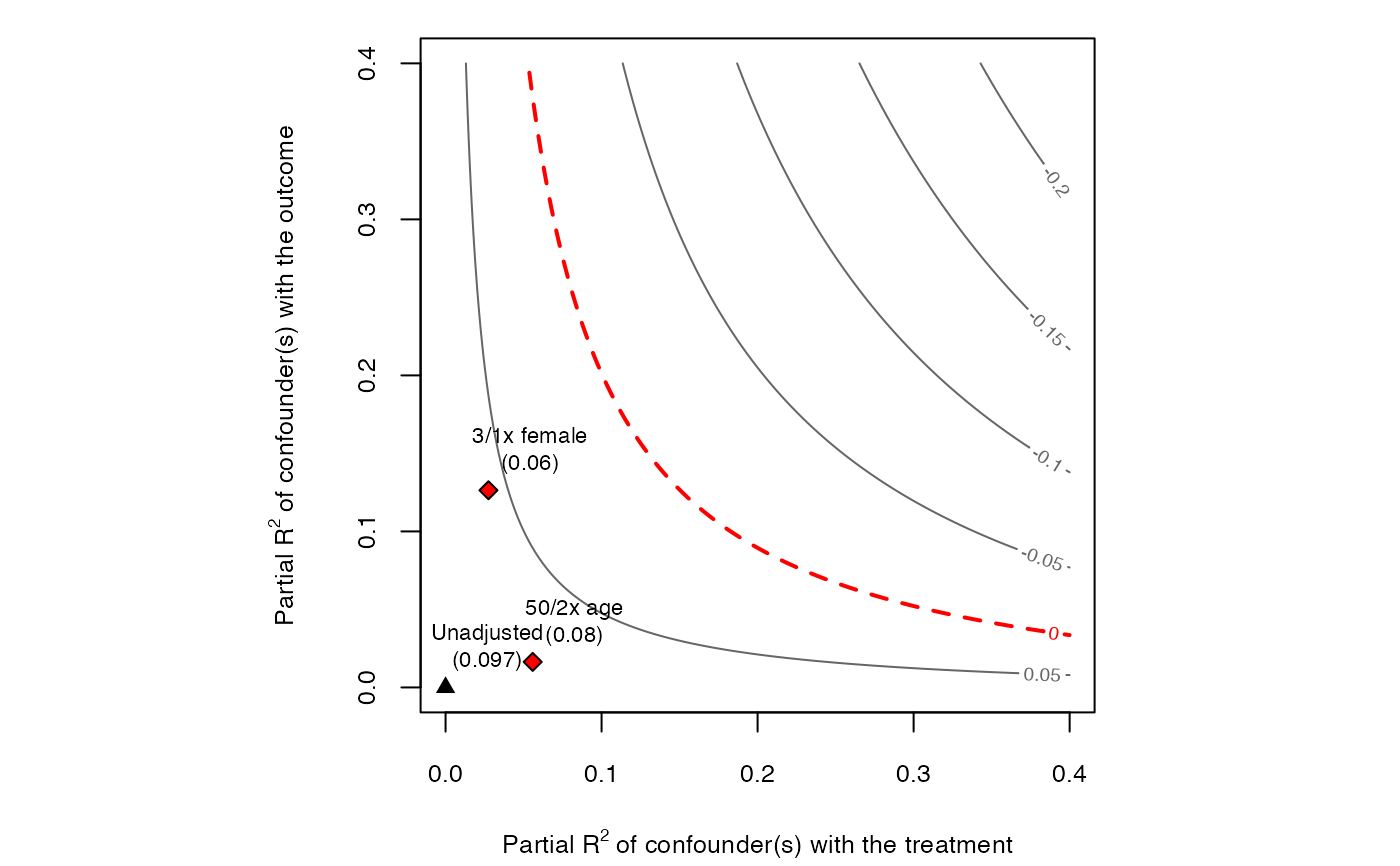Convenience function to add bounds on a sensitivity contour plot created with ovb_contour_plot.
add_bound_to_contour(model, ...)
# S3 method for lm
add_bound_to_contour(
model,
benchmark_covariates,
kd = 1,
ky = kd,
bound_label = NULL,
treatment = plot.env$treatment,
reduce = plot.env$reduce,
sensitivity.of = plot.env$sensitivity.of,
label.text = TRUE,
cex.label.text = 0.7,
label.bump.x = plot.env$lim * (1/15),
label.bump.y = plot.env$lim.y * (1/15),
round = 2,
...
)
# S3 method for fixest
add_bound_to_contour(
model,
benchmark_covariates,
kd = 1,
ky = kd,
bound_label = NULL,
treatment = plot.env$treatment,
reduce = plot.env$reduce,
sensitivity.of = plot.env$sensitivity.of,
label.text = TRUE,
cex.label.text = 0.7,
label.bump.x = plot.env$lim * (1/15),
label.bump.y = plot.env$lim.y * (1/15),
round = 2,
...
)
# S3 method for numeric
add_bound_to_contour(
r2dz.x,
r2yz.dx,
bound_value = NULL,
bound_label = NULL,
label.text = TRUE,
cex.label.text = 0.7,
font.label.text = 1,
label.bump.x = plot.env$lim * (1/15),
label.bump.y = plot.env$lim.y * (1/15),
round = 2,
point.pch = 23,
point.col = "black",
point.bg = "red",
point.cex = 1,
point.font = 1,
...
)Arguments
- model
An
fixestobject with the outcome regression.- ...
arguments passed to other methods.
- benchmark_covariates
The user has two options: (i) character vector of the names of covariates that will be used to bound the plausible strength of the unobserved confounders. Each variable will be considered separately; (ii) a named list with character vector names of covariates that will be used, as a group, to bound the plausible strength of the unobserved confounders. The names of the list will be used for the benchmark labels. Note: for factor variables with more than two levels, you need to provide the name of each level as encoded in the
fixestmodel (the columns ofmodel.matrix).- kd
numeric vector. Parameterizes how many times stronger the confounder is related to the treatment in comparison to the observed benchmark covariate. Default value is
1(confounder is as strong as benchmark covariate).- ky
numeric vector. Parameterizes how many times stronger the confounder is related to the outcome in comparison to the observed benchmark covariate. Default value is the same as
kd.- bound_label
label to bounds provided manually in
r2dz.xandr2yz.dx.- treatment
A character vector with the name of the treatment variable of the model.
- reduce
Should the bias adjustment reduce or increase the absolute value of the estimated coefficient? Default is
TRUE.- sensitivity.of
should the contour plot show adjusted estimates (
"estimate") or adjusted t-values ("t-value")?- label.text
should label texts be plotted? Default is
TRUE.- cex.label.text
size of the label text.
- label.bump.x
bump on the x coordinate of label text.
- label.bump.y
bump on the y coordinate of label text.
- round
integer indicating the number of decimal places to be used for rounding.
- r2dz.x
Hypothetical partial R2 of unobserved confounder Z with treatment D, given covariates X.
- r2yz.dx
Hypothetical partial R2 of unobserved confounder Z with outcome Y, given covariates X and treatment D.
- bound_value
value to be printed in label bound.
- font.label.text
font for the label text.
- point.pch
plotting character for
points.- point.col
color code or name for
points.- point.bg
backgrounf (fill) color for
points.- point.cex
size of
points.- point.font
font for
points.
Value
The function adds bounds in an existing contour plot and returns `NULL`.
Examples
# runs regression model
model <- lm(peacefactor ~ directlyharmed + age + farmer_dar + herder_dar +
pastvoted + hhsize_darfur + female + village,
data = darfur)
# contour plot
ovb_contour_plot(model = model, treatment = "directlyharmed")
# add bound 3/1 times stronger than female
add_bound_to_contour(model = model,
benchmark_covariates = "female",
kd = 3, ky = 1)
# add bound 50/2 times stronger than age
add_bound_to_contour(model = model,
benchmark_covariates = "age",
kd = 50, ky = 2)
